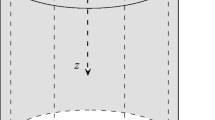Abstract
This work presents a formulation based on UPML for truncating conductive media by using a local and non-orthogonal coordinate system to solve Maxwell’s equations by the FDTD method. The detailed procedure for obtaining the UPML equations for this case is shown and the complete equation set is provided.
Similar content being viewed by others
References
Bayliss, A., Turkel, E.: Radiation boundary conditions for wave-like equations. Comm. Pure Appl. Math. 23, 707–725 (1980)
Berenger, J.: A perfectly matched layer for the absorption of electromagnetic waves. J. Computational Phisics 114, 185–200 (1994)
Gedney, S.D.: An anisotropic perfectly matched layer absorbing media for the truncation of FDTD latices. IEEE Trans. Antennas Propag. 44, 1630–1639 (1996)
Gedney, S.D., Roden, J.A.: Numerical stability of nonorthogonalFDTD methods. IEEE Trans. Antennas Propag. 48(2), 231–239 (2000)
Higdon, R.: Numerical absorbing boundary conditions for the wave equation. Math. Comput. 49, 65–90 (1987)
Holland, R., Williams, J.: Total-field versus scattered-field finite-difference. IEEE Trans. Nucl. Sci. 30, 4583–4588 (1983)
Liao, Z., Wong, H., Yang, B.P., Yuan, Y.F.: A transmitting boundary for transient wave analysis. Sci. Sin. XXVII(series A), 1063–1076 (1984)
Mur, G.: Absorbing boundary conditions for the finite-difference approximation of the time-domain electromagnetic field equations. IEEE Trans. Electromagn. Compat. 23, 377–382 (1981)
Taflove, A., Hagness, S.C.: Computational Electrodynamics, The Finite-Difference Time-Domain Method. Artech House Inc., 3 edn. (2005)
Tuma, E.T., de Oliveira, R.M.S., Sobrinho, C.L.S.S.: New model of current impulse injection and potential measurement in transient analysis of grounding systems in homogeneous and stratified soils using the FDTD method. In: International Symposium on Lightning Protection (SIPDA). Sao Paulo, Brazil (2005)
Yee, K.: Numerical solution of initial boundary value problems involving Maxwell’s equations in isotropic media. IEEE Trans. Antennas Propag. 14, 302–307 (1966)
Yung, E.K.-N., Tam, W.-Y.: Analysis of a circular earthing plate. In: IEE proceedings. Part C. Generation, transmission and distribution (IEE Proc. C) (1989)
Author information
Authors and Affiliations
Corresponding author
Rights and permissions
About this article
Cite this article
de Oliveira, R.M.S., Sobrinho, C.L.S.S. UPML formulation for truncating conductive media in curvilinear coordinates. Numer Algor 46, 295–319 (2007). https://doi.org/10.1007/s11075-007-9139-6
Received:
Accepted:
Published:
Issue Date:
DOI: https://doi.org/10.1007/s11075-007-9139-6




